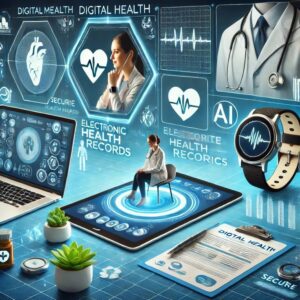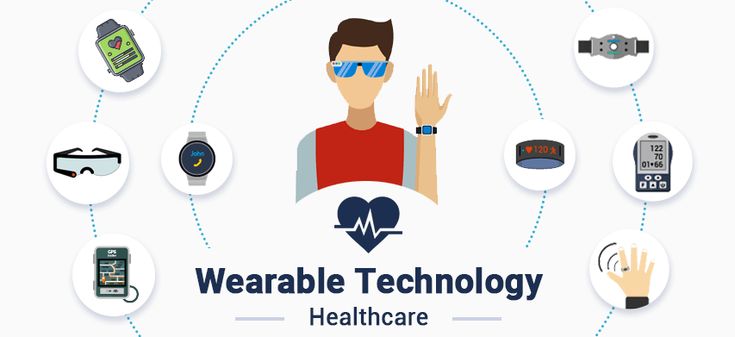⌚ The Revolution in Health Monitoring: A New Era of Continuous Monitoring.

Wearable devices and mobile integration have sparked a revolution in the health monitoring sector that will transform traditional medical systems. Modern smartwatches and fitness trackers have moved beyond just counting steps and are now equipped with medical-grade sensors that can monitor vital signs continuously and in real-time. PPG (Photoplethysmography) technology for heart rate monitoring has made it possible to detect cardiac arrhythmias, while devices with ECG (Electrocardiogram) functions can detect serious conditions like atrial fibrillation. Devices with blood oxygen level monitoring (SpO2) gained significant importance during COVID-19, as they can recognize early signs of hypoxia. Advanced sleep analysis algorithms are accurately identifying sleep stages, REM sleep, and issues like sleep apnea. Devices with body composition analysis can determine body fat, muscle mass, and hydration levels. Stress monitoring devices analyze autonomic nervous system activity through HRV (Heart Rate Variability). Skin temperature sensors track changes in body temperature. All this data integrates through mobile applications to form a comprehensive health profile that provides valuable information for both users and doctors.
🏥 Personal Medical Technology: Disease Prevention and Management
Wearable-mobile integration has introduced a new model for chronic disease management that is fundamentally transforming disease prevention and control. For diabetic patients, CGM (Continuous Glucose Monitoring) systems track blood sugar levels in real-time and alert them to dangerous fluctuations. Smartwatches with blood pressure monitoring provide 24/7 surveillance for hypertension patients. For asthma patients, smart inhalers record medication usage data and identify environmental triggers. For heart patients, single-lead ECG devices can detect conditions like atrial fibrillation. For epilepsy patients, seizure detection algorithms detect abnormal movements. For osteoporosis patients, activity trackers can assess bone health. For patients with digestive disorders, smart pills monitor the digestive process. All these systems are making disease management more proactive and data-driven.
💊 Innovation in Medication Management: Personalized Treatment
Wearable-mobile integration has introduced advanced solutions to improve medication adherence, proving far more effective than traditional methods. Smart pill boxes not only remind patients of medication times but also verify whether the patient has actually taken the medicine. Devices with medication adherence sensors record medication usage data in real-time. Dose tracking apps log dosage times and identify potential drug interactions. Side effect monitoring systems track patient symptoms and send alerts to doctors. Drug interaction checkers analyze medication interactions and prevent dangerous combinations. Prescription management apps help manage prescriptions and handle automatic refills. Refill reminders notify patients to renew their medications. Together, all these systems can improve medication adherence by 40-60%, playing a crucial role in chronic disease management.
🧠 Mental Health Care: Modern Solutions
Wearable-mobile integration has added a new dimension to mental health care, complementing traditional therapy methods. Mood tracking apps monitor users’ emotional fluctuations and identify patterns. Stress management sensors analyze stress levels through HRV (Heart Rate Variability). Meditation guides teach mindfulness and relaxation techniques. Anxiety monitoring systems detect anxiety attacks through physiological signs like heart rate and breathing rate. Sleep quality analyzers assess sleep quality and identify issues like insomnia. Cognitive behavioral therapy apps provide digital therapy sessions. Mental health assessments evaluate mental well-being using standardized questionnaires. Together, all these solutions are making mental health care more accessible and affordable.
🏃 Fitness and Wellness: Personalized Training Programs
Wearable-mobile integration has elevated the fitness industry to a new level of personalization. Workout tracking apps not only record exercise sessions but also provide recommendations for form correction and technique improvement. Calorie expenditure calculators provide the most accurate estimates based on BMR (Basal Metabolic Rate) and activity level. Heart rate zone monitors track heart rate during different intensity levels. GPS tracking apps accurately determine distance, speed, and elevation gain. Recovery monitoring systems analyze physical recovery through HRV and sleep data. Personalized training plans create workout schedules tailored to individual goals and fitness levels using AI algorithms. Fitness challenges boost motivation through gamification. Together, all these features form a comprehensive fitness ecosystem.
🍎 Nutrition Management: Maintaining a Balanced Diet
Wearable-mobile integration has established nutrition management on a scientific foundation. Food tracking apps can easily record food intake using barcode scanners and food recognition technology. Nutrient analysis tools provide detailed analysis of macronutrients and micronutrients. Calorie counting apps determine daily calorie needs based on BMR and activity level. Meal planning apps create meal plans according to dietary preferences and health goals. Hydration tracking apps monitor water intake and send reminders. Allergen detection systems identify allergy-causing ingredients. Dietary recommendation apps provide nutritional suggestions based on medical conditions and lifestyle. Together, all these systems enable evidence-based nutrition management.
👵 Elderly Care: Protecting Health with Aging
Wearable-mobile integration has given a new dimension to elderly care, enabling independent living for the aging population. Fall detection sensors detect falls using accelerometers and gyroscopes and send automatic emergency alerts. Emergency response systems provide emergency response facilities through SOS buttons and automatic fall detection. Medication reminders notify about medication times and send notifications to caregivers. Vital signs monitoring continuously tracks blood pressure, heart rate, and blood oxygen. Location tracking apps track location via GPS and provide geofencing alerts. Cognitive function assessments evaluate cognitive function through memory tests and cognitive games. Social connectivity tools provide social connection facilities through video calling and messaging. Together, all these features improve seniors’ safety and independence.
🤰 Maternal and Child Health: Prenatal and Postnatal Care
Wearable-mobile integration has brought revolutionary changes to maternal and child health care. Pregnancy tracking apps track weekly pregnancy progress, fetal development, and maternal health. Fetal heart rate monitors monitor the fetal heartbeat using Doppler technology. Contraction timing tools measure the frequency and duration of uterine contractions. Breastfeeding trackers monitor feeding sessions, duration, and patterns. Baby growth monitors track weight, length, and head circumference data. Postpartum recovery systems monitor maternal vital signs, mood changes, and physical recovery. Infant health assessments track developmental milestones and vaccination schedules. Together, all these systems provide comprehensive maternal and child health care.
🏋️ Professional Sports: Performance Improvement
Wearable-mobile integration has taken performance optimization in professional sports to new heights. Performance analytics apps provide biomechanical data, movement patterns, and tactical analysis. Injury prevention systems identify muscle imbalances, fatigue levels, and overtraining risks. Recovery optimization tools suggest optimal recovery strategies based on sleep quality, nutrition, and hydration data. Training load monitors track workout intensity, volume, and frequency. Biomechanical analysis tools analyze joint angles, force production, and movement efficiency. Hydration and nutrition monitors track sweat rate, electrolyte balance, and energy expenditure. Sleep and rest trackers analyze sleep stages, recovery quality, and circadian rhythms. Together, all these data points help maximize athletes’ performance.
🔬 Research and Development: Aiding Medical Research
Wearable-mobile integration has fundamentally changed the methods of medical research. Clinical trial recruitment apps facilitate the identification and enrollment of potential participants. Real-world data collection systems gather data for large-scale longitudinal studies. Patient-reported outcomes collect data on symptoms, quality of life, and treatment effectiveness. Remote monitoring tools enable remote monitoring of participants in clinical trials. Data analytics platforms provide advanced statistical analysis and machine learning algorithms. Research collaboration tools facilitate data sharing and collaboration between different institutions. Evidence generation systems validate treatment effectiveness through real-world evidence. Together, all these advances are making medical research more efficient and comprehensive.


